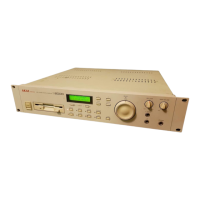INTRODUCTION
S2000 Operator’s Manual - Version 1.30 Page 19
Going to the next page down allows you to set each part’s MIDI channel in the same way:
Select the part using the outer wheel and set the channel using the inner wheel. The same
technique can be used to set level, pan and all other part parameters. Again, you can set up a
multi very quickly and easily without hardly moving your hand.
However, you may also select the part like any other parameter by moving the cursor to the PT
field and using the inner DATA wheel to select the part.
As with EDIT PROGRAM, both methods have their uses. Using the SELECT wheel, you can
make rapid changes to the the same parameter across several different parts by placing the
cursor on the parameter you wish to edit, editing it, flicking the SELECT wheel to select the
next part, editing it, flicking the SELECT wheel, editing it, etc.. However, in cases wher you
may wish to go from part 1 to part 16, because the SELECT wheel takes a second or so to get
going when you hold it down in either direction, you may find moving the cursor to the PT field
and using the DATA wheel a bit faster.
THE SELECT WHEEL IN EDIT SAMPLE
In EDIT SAMPLE, you will see that recordings can have very long numbers as each recording
can have tens of thousands of sample points (a one second recording has 44,100 sample
points!) and so, to allow you to set the resolution at which you edit these recording, the outer
wheel is used to move the cursor around within long numbers. For example, in the TRIM
START page, you may see this display:
Here the cursor under the 5 indicating that you will edit the thousands of samples with the
inner DATA wheel. For finer editing, however, flick the outer wheel clockwise to receive this
display:
Now you are editing the hundreds. Flick it twice more and you will be editing individual
samples. I.e.:
In this way, you can flick between coarse sample editing and fine sample editing without hardly
moving your hand. Of course, the same technique can be used when setting loops, end
times, crossfade lengths or any other sample parameter that has many, many digits.

